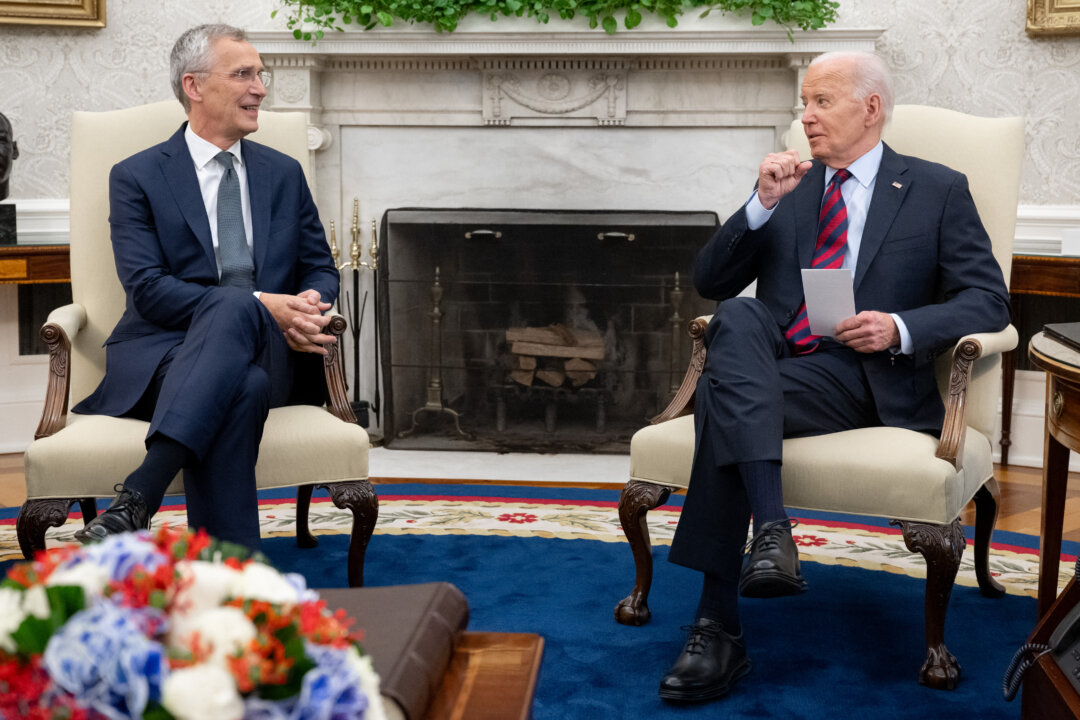Mr. Stoltenberg confirmed that spending among Canada and European member nations has increased by 18 percent—the largest increase in decades.
North Atlantic Treaty Organization (NATO) Secretary General Jens Stoltenberg met with President Joe Biden in Washington on June 17 and announced that more than 20 of the 32 member nations have committed to their spending goal.
NATO members previously agreed to spend at least 2 percent of their gross domestic product on defense. President Biden touted the fact the number of member nations committing to 2 percent has doubled since he took office.
Mr. Stoltenberg also confirmed that spending among Canada and European member nations has increased by 18 percent—the largest increase in decades.
Only six nations were meeting that goal before Russia invaded Ukraine. Former President Donald Trump had long been critical of NATO countries that did not meet their share of defense spending and had threatened not to defend alliance members if they did not pay their agreed upon share.
Speaking with the press after the bilateral meeting, Mr. Stoltenberg said the NATO Summit next month would mark the 75th anniversary of “the most successful alliance in history” and make decisions on increasing defense spending and taking a lead role in providing security assistance and military training for Ukraine.
President Biden and Mr. Stoltenberg gave joint remarks to members of the press, expressing their gratitude for each other and the work they’ve done to strengthen NATO’s defense capabilities and efforts to support Ukraine.
White House National Security Communications Adviser John Kirby told reporters that the president would reaffirm “the ironclad U.S. commitment to Article 5 of the Washington Treaty,” which states that an armed attack against one NATO nation would be considered an attack against all of them.
More Support for Ukraine
Mr. Stoltenberg said he expects more funding for Ukraine to come from Canada and European allies at the summit and shared his expectations for security and training measures.
“We will agree that NATO will take on a lead role in providing security assistance and training,” he said. “I expect that this will be led by a three-star general … and provide the logistics and the support to set up the capabilities that Ukraine needs.”
It will most likely be at a U.S. facility located in Germany and have several hundred personnel organizing and facilitating the security assistance for Ukraine, he said.
Mr. Stoltenberg also reaffirmed his desire to streamline Ukraine’s eventual admittance into NATO, saying that the membership “assures the war really ends.”
He also praised the G7’s decision to utilize frozen Russian assets to provide a loan to Ukraine and rejected Russian President Vladimir Putin’s offer for a ceasefire, which entailed Kyiv withdrawing all troops from the four eastern provinces Russia annexed in 2022 and renouncing any plans to join NATO.
“This is this is not a peace offer,” Mr. Stoltenberg said. “This is a proposal that Russia should actually achieve its war aims by convincing Ukraine to give up its sovereignty and territorial integrity.”
‘Nuclear Transparency’
Mr. Stoltenberg’s meeting in Washington comes the day after he appeared to suggest deploying more nuclear weapons in response to Russia’s continued war in Ukraine.
He revealed in an exclusive interview with The Telegraph, published on June 16, that NATO members were in talks about deploying more nuclear weapons, taking them out of storage, and placing them on standby in response to what he saw as a growing threat from Russia and China.
He also called for “nuclear transparency” among the alliance members and a modernization of defense systems, such as the ongoing replacement of F-16 fighters with F-35s, which have the capability to hold U.S. nuclear weapons.
Kremlin spokesman Dmitry Peskov said Mr. Stoltenberg’s remarks were “nothing but another escalation of tension” and that they appeared to contradict a previous communique that said any use or threat of nuclear weapons in the context of Ukraine was inadmissible.
Mr. Stoltenberg later said that Russia was trying to create confusion and said his comments were about modernizing NATO’s nuclear deterrent. He also added that there are no plans to increase the number of weapons.
Only three of the member nations have nuclear weapons: the United States, UK, and France. American tactical nuclear weapons are held within Belgium, Germany, Italy, the Netherlands, and Turkey.
Mr. Kirby addressed these comments before the bilateral meeting, saying that the administration is “comfortable with our strategic deterrent posture,” not only in Europe but around the world, although he would not talk about the nuclear posture with any specificity.
“NATO is a defensive alliance and NATO countries are some of the most sophisticated in the world when it comes to military capabilities,” Mr. Kirby said. “It would be irresponsible when improving if we weren’t constantly talking to our NATO allies about how to make sure we can meet our commitments to one another across a range of military capabilities.”
Mr. Stoltenberg, the former Norwegian Prime Minister, has been at the helm of NATO for 10 years, getting his term extended four times. His current term expires on Oct. 1.
While in North America, Mr. Stoltenberg will meet with U.S. Secretary of State Antony Blinken and members of the Senate Foreign Relations Committee on June 18, as well as Senators like Minority Leader Mitch McConnell and members of the Senate NATO Observer Group.
On June 19, he will travel to Ottawa, Canada, to meet with Canadian Prime Minister Justin Trudeau. On June 20, he will return to Washington for a meeting with White House National Security Adviser Jake Sullivan, as well as with Reps. Mike Turner (R-Ohio) and Gerry Connolly (D-Va.).
Andrew Thornebrooke, Reuters, and The Associated Press contributed to this report.

